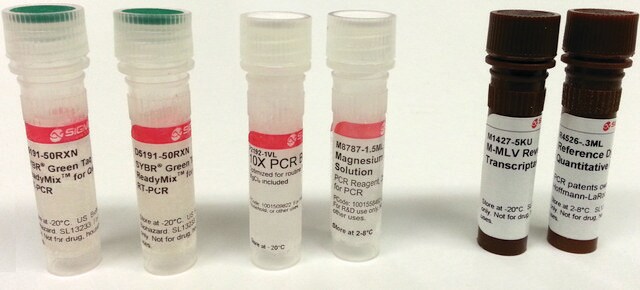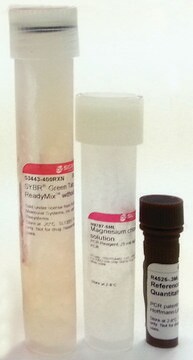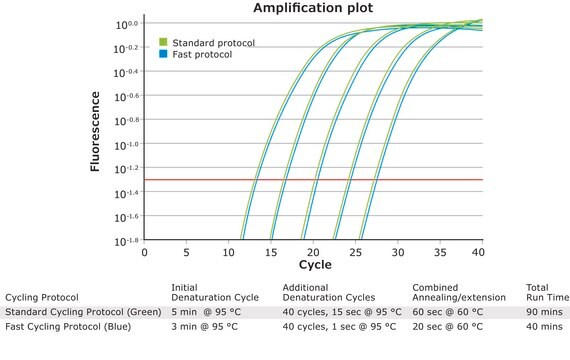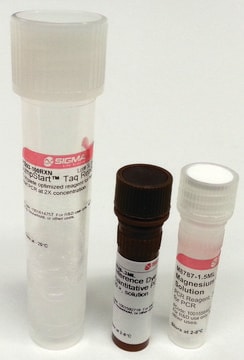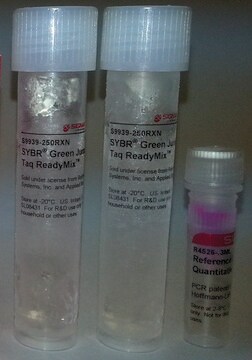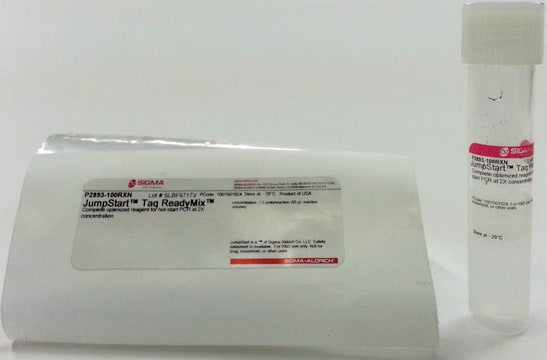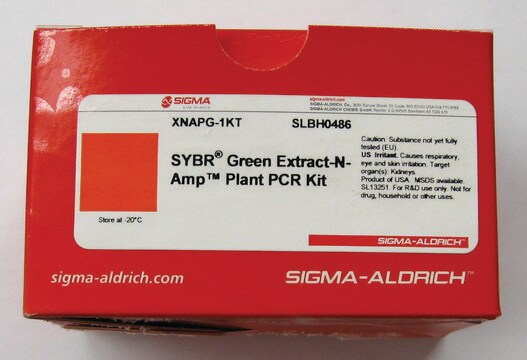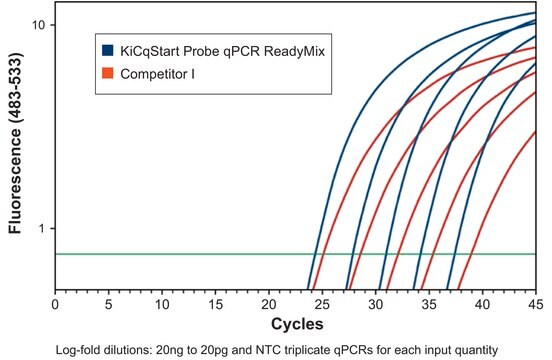R4526
Reference Dye for Quantitative PCR
100 ×, solution
Sinonimo/i:
Reference dye for qPCR, ROX
Autenticatiper visualizzare i prezzi riservati alla tua organizzazione & contrattuali
About This Item
Codice UNSPSC:
41106300
NACRES:
NA.55
Prodotti consigliati
Stato
solution
impiego
sufficient for ≥600 reactions
Concentrazione
100 ×
tecniche
PCR: suitable
Colore
red
Solubilità
water: soluble
Temperatura di conservazione
2-8°C
Categorie correlate
Descrizione generale
Sigma′s Reference Dye for quantitative polymerase chain reaction (qPCR) is a proprietary dye for use with real-time PCR. It is used for the normalization of reaction data when using SYBR Green, molecular probes, or dual-labeled probe chemistries for real-time detection. The Reference Dye is supplied as a 100× solution with a maximum excitation and emission of 586 nm and 605 nm, respectively. Instrument settings for ROX reference dye are satisfactory for the measurement of Reference Dye for qPCR.
Applicazioni
Reference Dye for Quantitative PCR has been used:
- in the preparation of mastermix for real time-quantitative polymerase chain reaction (RT-qPCR)
- as a component of the reaction mixture for detection of Clostridium difficile by quantitative polymerase chain reaction (qPCR)
- for analyzing the degree of cellular DNA contamination by qPCR
Altre note
Reference Dye for Quantitative PCR is forR&D use only. Not for drug, household, or other uses.
Prodotti correlati
N° Catalogo
Descrizione
Determinazione del prezzo
Avvertenze
Warning
Indicazioni di pericolo
Consigli di prudenza
Classi di pericolo
Aquatic Acute 1 - Aquatic Chronic 1 - Eye Irrit. 2 - Skin Irrit. 2 - Skin Sens. 1
Codice della classe di stoccaggio
12 - Non Combustible Liquids
Classe di pericolosità dell'acqua (WGK)
WGK 3
Punto d’infiammabilità (°F)
Not applicable
Punto d’infiammabilità (°C)
Not applicable
Dispositivi di protezione individuale
Eyeshields, Gloves
Scegli una delle versioni più recenti:
Possiedi già questo prodotto?
I documenti relativi ai prodotti acquistati recentemente sono disponibili nell’Archivio dei documenti.
I clienti hanno visto anche
Increased environmental sample area and recovery of Clostridium difficile spores from hospital surfaces by quantitative PCR and enrichment culture
Brown KA, et al.
Infection Control and Hospital Epidemiology : The Official Journal of the Society of Hospital Epidemiologists of America, 39(8), 917-923 (2018)
Partial deletion of rng (RNase G)-enhanced homoethanol fermentation of xylose by the non-transgenic Escherichia coli RM10
Manow R, et al.
Journal of Industrial Microbiology & Biotechnology, 39(7), 977-985 (2012)
Sambrook, J. et al.
Molecular Cloning: A Laboratory Manual, 3rd (2000)
Araceli Melendez-Avalos et al.
Folia microbiologica, 65(1), 133-142 (2019-05-20)
This study aimed to analyze the proinflammatory cytokine mRNA expression in the urinary tract of BALB/c mice infected with bacterial strains with uropathogenic potential. Groups of four 6-week-old female BALB/c mice were intraurethrally inoculated with 5 × 107 colony-forming units (CFU) of
Gustav Johansson et al.
Molecular cancer therapeutics, 20(12), 2568-2576 (2021-09-24)
The majority of patients diagnosed with advanced gastrointestinal stromal tumors (GISTs) are successfully treated with a combination of surgery and tyrosine kinase inhibitors (TKIs). However, it remains challenging to monitor treatment efficacy and identify relapse early. Here, we utilized a
Il team dei nostri ricercatori vanta grande esperienza in tutte le aree della ricerca quali Life Science, scienza dei materiali, sintesi chimica, cromatografia, discipline analitiche, ecc..
Contatta l'Assistenza Tecnica.